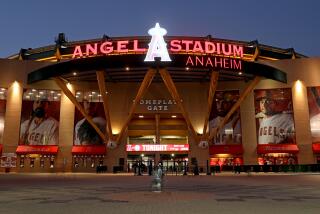San Jose’s Election Pitch to Lure Giants From San Francisco
- Share via
SAN JOSE — Across from an open field where Highway 237 and Zanker Road meet, 5,000 trailer park residents live in “the forgotten part of San Jose.”
Most people drive by without a glance.
But since January, that 154-acre site has been the focus of national attention, as sports fans wonder if California’s third most populous city will build a baseball stadium there to lure the San Francisco Giants south.
On June 2, voters in this city of 800,000 residents will decide the issue in an election that’s as difficult to predict as a knuckleball thrown on a windy day at Candlestick Park, the current home of the Giants.
“It’ll be good for the city, but not for the residents,” said mobile home owner Mearl Sparks, 63. “If it’s built, I’ll probably go to the games, but I don’t see why we should have to pay for a private enterprise.”
But neighbor Joe Avila, a part-time assistant manager of a video store, said he thinks San Jose civic leaders are right in believing that a national sports team would bring prestige and dollars to the city that has long lived in San Francisco’s chic shadow, cast from 50 miles north.
“We’re the forgotten part of San Jose,” said Avila, who has lived in the park for five years amid open land and boxy business parks. “I think it’ll be great to build a stadium to get a little activity out here.”
Giants owner Bob Lurie has been trying for several years to free his team from Candlestick, where baseball players and fans have endured three decades of swirling winds in a stadium that’s often colder than the beer.
Baseball Commissioner Fay Vincent is rooting for the San Jose deal, saying it might be the last chance to keep the team in California.
“The San Francisco team cannot play in Candlestick much longer,” Vincent said. “The Giants are going to play somewhere else. Candlestick is not a hospitable place for baseball.”
San Francisco voters have twice turned down plans for a new stadium to keep the team, which left New York in 1960 after the Big Apple refused to build a new ballpark to replace the aging Polo Grounds. The Candlestick lease expires in 1994.
In November 1990, voters in Santa Clara County, whose seat is San Jose, also refused to pass a measure to build a sports complex for the Giants.
The new stadium plan, Measure G on San Jose’s June 2 ballot, grew out of a January pact between the Giants and Mayor Susan Hammer, a rookie who spent weeks during her first year on the job negotiating the deal.
The measure asks voters to authorize spending city “general funds” to help build a 45,000-48,000-seat open air grass-field stadium, and to pay for education and anti-drug and anti-crime programs in a package deal.
The ballot question doesn’t mention the $265 million cost to build the ballpark and improve the site, or the planned funding method--a proposed utility tax rate hike from 5% to 7%.
It would cost the average household $35 a year, and businesses thousands more.
The Giants would pay $30 million and cover construction overruns. The city would pick up the rest, leasing the ballpark to the team for 30 years.
The stadium would be finished in time for the 1996 baseball season. And the team would be dubbed “San Jose Giants,” giving what Mayor Hammer calls “major league status” to California’s third largest city behind No. 1 Los Angeles and No. 2 San Diego.
San Francisco, with about 730,000 residents, fell behind San Jose in population about three years ago.
Leading politicians and business groups have backed the stadium plan, although large companies such as International Business Machines Corp. don’t support the utility tax hike, which the City Council must approve.
A group called Citizens Against Stadium Taxes formed to oppose the project, arguing against making residents shoulder the costs.
“This is a private project, no matter how many false promises the politicians give us,” said Kathy Napoli, a CAST leader.
But the group of about 400 active anti-stadium volunteers is overmatched by a well-run pro-stadium campaign complete with a professional director who helped raise more than $500,000 and register 15,000 voters.
“We’re pulling out all the stops because this is the campaign to win,” said Ed McGovern, manager of the Giants Stadium Campaign. “If we lose this one I would bet a dime to a donut that the team’ll be moving to Tampa or St. Petersburg.
“It’ll be a squeaker, but all good races are.”
Those Florida cities, like several others nationwide, have been angling for a major league team, which fiscal experts say can bring $50 million to $90 million in annual benefits to a local economy.
More to Read
Go beyond the scoreboard
Get the latest on L.A.'s teams in the daily Sports Report newsletter.
You may occasionally receive promotional content from the Los Angeles Times.










